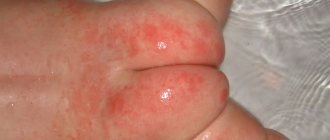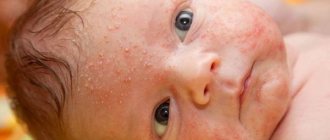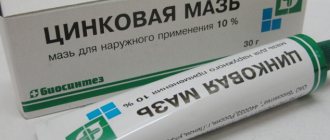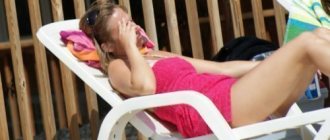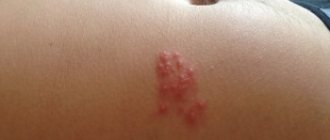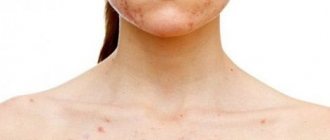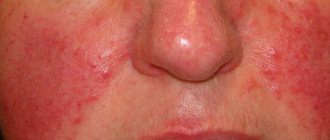Acne concept. What is it?
Acne or acne (vulgaris) is an inflammatory disease of the human skin that occurs during transformations in the pilosebaceous structures.
Acne is the most common skin disease. When acne occurs, the action of the sebaceous glands and hair follicles is disrupted. Acne in newborns is a small inflammatory formation with a whitish or yellowish purulent tip. Acne in children can appear on different parts of the body: such as the forehead, nose, cheeks, ears, and less often on the back or neck. This type of disease occurs in 35 - 40 percent of children and has similarities with acne observed in adolescence.
This type of acne is medically called “neonatal cephalic pustulosis.”
Acne in infants
Neonatal acne is a non-infectious inflammatory process that occurs as a result of disruption of the sebaceous glands and blockage of the sebaceous ducts. Acne is accompanied by the appearance of small red or white dots with a purulent head.
According to statistics, in 25-30% of newborn babies, a neonatal rash appears immediately or 2-3 weeks after birth. It is characterized by a short duration and moderate severity. Since the disease is hormonal in origin, external factors do not have any influence on the development of the disease.
This happens due to physiological reasons:
- the residual effect of the hormone estrogen present in excess quantities in a woman’s body (in the last stage of pregnancy and during childbirth) on the fragile body of the baby;
- the entry of certain elements into the child’s body during breastfeeding (if the mother has an excess amount of hormones);
- functional malfunctions of the sebaceous glands;
- changes in the child's hormonal levels.
Neonatal rash (bloom) in children is a unique way for the body to adapt to new conditions. At the moment of birth, the child experiences excessive activity of sex hormones and the sebaceous glands begin to intensively produce sebaceous secretions, which leads to clogging of pores and the formation of acne. The localization of the rash in children occurs on the face - in the area of the cheeks, forehead, nose, chin, scalp, and is occasionally observed in the ears and neck.
With hormonal rashes, disturbances in the child’s behavior are not observed. He has a good appetite and normal sleep. The baby remains alert and active, so no medications are required; you need to wait until the rash goes away on its own.
How to distinguish flowering from allergies in a newborn: reasons, differences, prohibitions
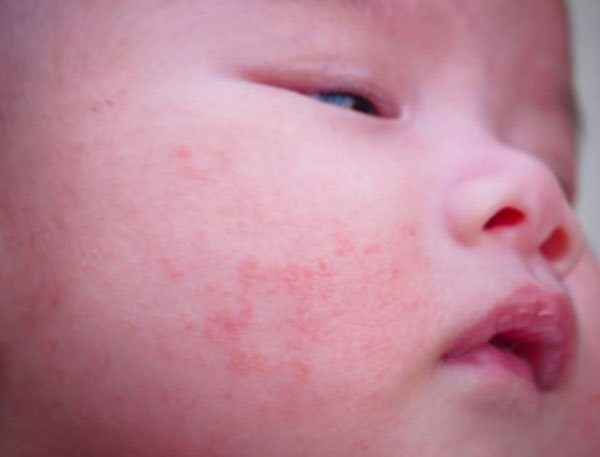
Allergies have visible differences from acne
You may have a question about rashes on your baby’s face. You will doubt whether your baby has newborn acne or allergies. Therefore, it is so important to be able to distinguish between these states.
- If an allergic reaction occurs, then the presence of completely red pimples is typical, while with acne they have a white head.
- The period of an allergic reaction is characterized by itching, severe restlessness of the baby, and attempts to scratch the pimples. With acne there is no sensation.
- An allergic reaction can occur in all parts of the child’s body, acne can occur on the head, neck and back.
- If an allergic reaction occurs, additional symptoms will likely be present. With acne there is only a rash.
Causes of rashes in newborns
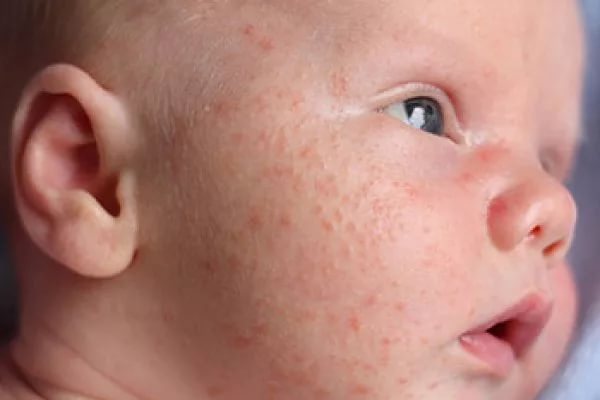
The skin of any adult, as well as a baby, shows the internal problems of the whole body. For a number of reasons, acne appears in children in the first weeks after birth. The main reason, according to doctors, is the increased amount of maternal sex hormones - estrogens, which reach the child in the womb.
- hormonal structure of the child (restructuring)
- excessive amount of sebaceous gland secretion at this stage
- clogging of pores and follicles
Doctors have not come to a consensus on the exact reasons for the appearance of pimples on the face of a newborn, but all theories are based on the opinion of a hormonal crisis and the restructuring of the baby’s body, its adaptation to the world and environment. Determining the boundaries of the duration of the rash, we can say that the maximum period is 4 months, minimum 3 weeks. Symptoms of the ongoing disease are the presence of small pimples on the child’s face and head.
Reasons, features, dangers
Acne in newborns usually occurs immediately after birth. It appears on the skin in the form of small red pimples with a yellowish or whitish hump of pus inside, like regular acne due to hormonal changes in adolescents.
In most cases, the rash appears 15 to 20 days after birth. Acne can cover a baby's entire face, but some babies have isolated pimples. The pathology is diagnosed in approximately one third of newborns.
If the rash is not caused by diseases of the internal organs and does not require therapy, then after 2–3 weeks it goes away on its own.
The main reason for the appearance of rashes is a hormonal crisis. Newborns have high levels of maternal sex hormones in their bodies. In addition, the child’s endocrine system is not yet fully formed and cannot cope with its functions.
Characteristic symptoms
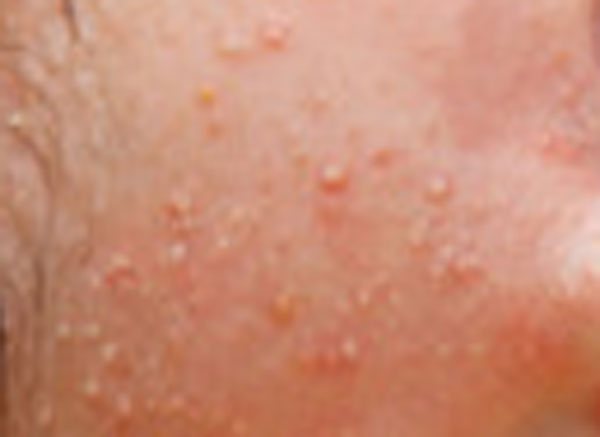
Let’s look at what acne looks like and how it manifests itself.
- The appearance of papules or pustules with a purulent apex is characteristic.
- There may be comedones, which will be closed or open. The first rashes may appear already in the first month of the baby’s life.
- Favorite areas for a short time are the face and scalp.
- Acne rashes do not cause anxiety in the toddler.
- It may go away on its own, especially upon reaching six months of age.
I bring to your attention a photo of this disease.
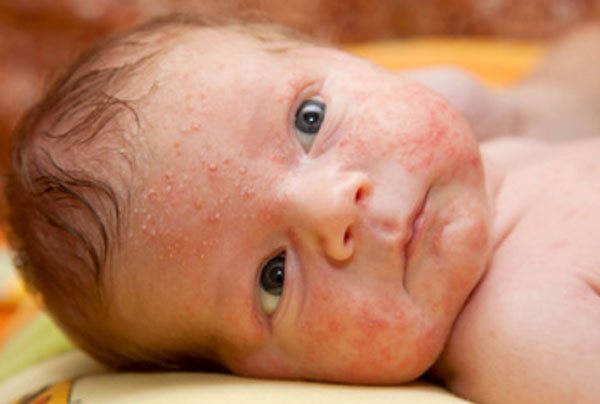
Manifestations of acne on the face
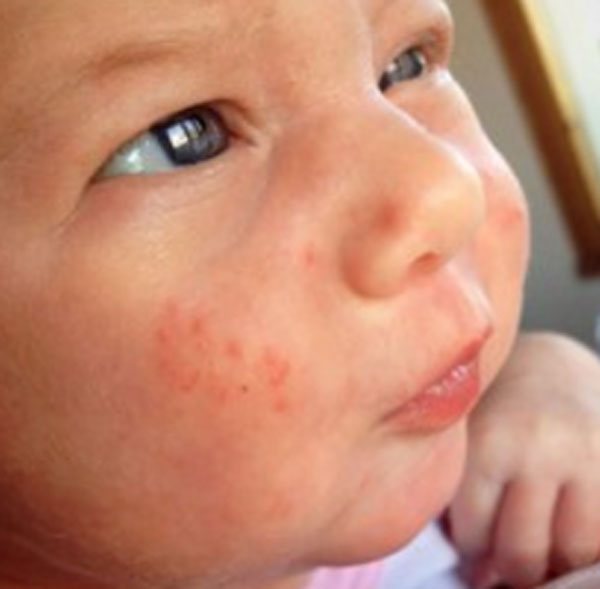
Manifestations of the disease on the cheeks of a child
A small skin rash can easily be confused with other diseases. Most often, flowering is confused with allergies and prickly heat.
Signs of allergic rashes
In order to take appropriate measures - if it is not possible to show the child to a doctor in the near future - it is important to know the main symptoms of an allergic rash:
- redness of the cheeks;
- the appearance of spots on the child’s skin that are rough to the touch;
- an increase in the total number of acne;
- problems with the baby's stool;
- abdominal pain (colic), accompanied by increased gas formation;
- dryness of the inflamed areas of the skin (in some cases, the inflamed areas begin to become wet).
In newborn babies, it is very difficult to determine the cause of rashes on your own. That is why, if alarming symptoms appear, it is necessary to consult a pediatrician who is observing the baby.
We also recommend watching:
- Blooming newborns
- Miliaria in newborns
- Cause of red cheeks in babies
- Rash on the face of a newborn
How to distinguish acne in newborns from allergies.
Before distinguishing a simple food allergy from acne, it is necessary to know the clinical picture. Nature of the rash: formation of purulent pustules and papules on the skin. The first signs of the disease appear from the first days of life or weeks.
Where does the rash occur? The location will be the skin of the chin, forehead and cheeks. In some children, acne may occur in the neck, eyelids and scalp. Less commonly, functional conditions occur on the upper chest.
When you realize that your baby has acne and this disease will go away on its own, it is worth determining whether it is an allergy?
- Place. An allergic rash occurs due to contact with irritating allergens, be it a cream, powder, or other substance. If you put cream on your baby’s back, then if an allergy develops, a rash will appear in this very place. It is worth noting that in most cases, acne appears on the baby’s face or neck, and allergies can spread throughout the body.
- Itching. Allergic effects, unlike acne, are accompanied by unpleasant itching.
- Colic. Loose stools. Temperature.
Parents should not worry about the condition of their baby, since acne disappears on its own after a hormonal surge. There will be no slightest scars or other traces of acne left on the skin. Acne does not cause physical suffering in a newborn.
Allergies in infants are divided into contact or food allergies. Food allergies are characterized by the presence of rough spots on the baby’s cheeks that rise above the entire skin of the child.
The skin becomes covered with pimples and spots also during allergic reactions and prickly heat. Hormonal rash in newborns appears only in certain places, looks like acne in teenagers, but does not cause discomfort.
Signs of prickly heat:
- It looks like a small but frequent rash of pink or bright red color.
- Almost always appears in places of close contact of the skin with clothing (armpits, neck, back, sides, in the area of skin folds).
- During the period of the rash, parents notice an increase in sweat production.
- Pimples do not have an abscess in the center.
- Miliaria often bothers a child. The skin is itchy and crusts appear on it after scratching.
Usually prickly heat is a signal that the child is not being properly cared for. Rashes appear due to poor skin hygiene. The phenomenon indicates that the baby is overheated due to too warm clothes or due to elevated body temperature.
Another cause of rashes is considered to be too frequent use of protective baby cream. These products are distinguished by a fatty base. After use, a film forms on the skin, which slows down heat transfer.
Consider the symptoms of allergic reactions:
- The main difference between allergies and acne is the localization of the rash. In the first case, pimples and redness of the skin can appear on any part of the skin.
- An allergic rash often itches a lot. Because of this, the child becomes restless, irritable, eats and sleeps poorly.
- Externally, an allergic reaction differs from acne in that pimples are prone to peeling, and fresh redness may look like slight swelling.
- In addition to rashes, the child often experiences a disorder in the digestive system. The baby often spits up, sometimes an allergic rash is accompanied by bloating and constipation.
Provoking factors for rashes of allergic etiology are poor diet, hereditary predisposition, aggressive laundry detergents, colds and medications. In contrast to this pathology, acne appears in infants for no apparent reason.
Hello, dear readers. Today we are talking about the main differences between flowering in newborns and allergies, and what the main symptoms parents should know.
Flowering in newborns is a completely harmless disease. These are pimples (rashes) on the baby’s face. Parents may confuse newborn blooms and allergies.
Therefore, from the moment a child is born, mothers and fathers should know how to distinguish allergies from flowering in newborns.
After all, allergies are not as harmless a disease as flowering, and usually do not go away on their own.
Flowering (hormonal rash), as statistics show, occurs in most newborns.
- While the baby is in the mother's womb, the mother shares with him not only valuable nutrients, but also hormones.
- The child is born, hormones continue to enter his body with milk during breastfeeding.
- There may be an excess of them, and then newborns develop a hormonal rash, popularly known as bloom.
- Doctors also call blooming an adaptation allergy: the baby (his digestive system) needs to get used to the new diet.
- A mother should remember this and eat properly and safely for her infant.
- In addition, flowering can be caused by excessive activity of the sebaceous glands in newborns (the cause is again hormones, their excess: the ducts on the baby’s skin are blocked).
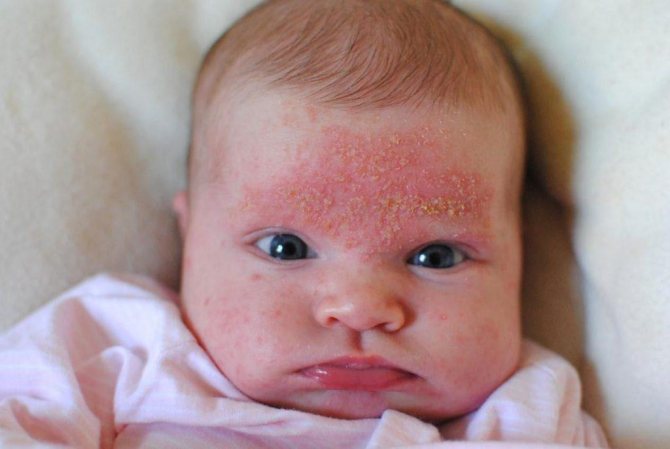
None of the reasons for flowering indicate any abnormalities in the baby’s body. Experts consider flowering to be a physiologically normal phenomenon.
- There is no need to treat such manifestations; very soon the newborn’s body will cope with this phenomenon on its own.
- The skin will clear as all systems return to normal, and foreign elements (mother’s hormones) will either be removed from the body, or the newborn’s body will adapt to them.
- In fact, flowering acts as a kind of adaptation measure for a newborn.
Of course, in the case of a large rash during flowering, the pediatrician can recommend traditional medicine: lotions made from decoctions of string and chamomile, which have long been known among the people. Herbs are also used for baths.
Sometimes a doctor prescribes zinc ointment (it dries out pimples), hydrogen peroxide (use cotton swabs with ointment on them no more than twice a day), Bepanten ointment (apply once or twice a day in a thin layer).
But more often than not, no even the mildest treatment is required at all. You just need to maintain perfect cleanliness, and also eat right for your mother.
The main difference between flowering and allergies in a baby is that rashes during flowering do not cause any discomfort in the baby: the skin does not itch, does not flake, does not itch.
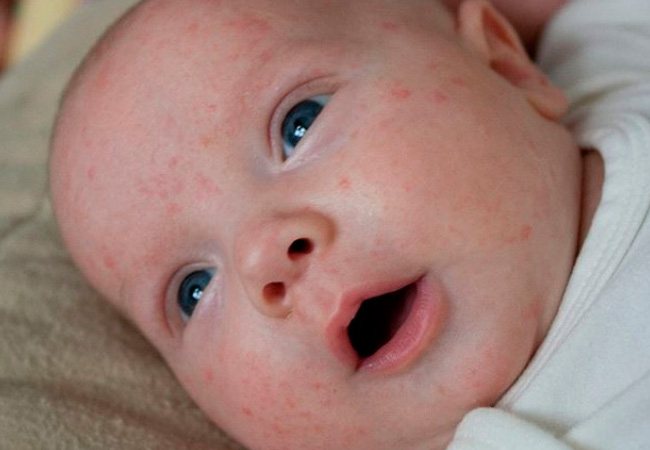
Whereas in allergic processes, any skin damage causes painful itching and burning. If a child has a rash on the skin, parents are concerned about a natural question: allergies or newborn bloom: how to distinguish them from each other?
During flowering (which, as mentioned above, is a physiological norm for newborns), in no case should you independently use hormonal drugs to level out the hormonal levels.
It is believed that the maximum duration of flowering is several weeks, and it can begin approximately a couple of weeks after the birth of the child.
It’s a different matter if a child has an allergy hidden under the guise of flowering.
Allergies in infants require quick and qualified action from a specialist.
How to distinguish allergies from flowering in a baby? The cause of allergies in infants may be the mother's consumption of allergenic foods during pregnancy and breastfeeding, and, of course, a hereditary factor.
- With allergies, changes in the skin itch and torment the baby, he is irritated, cries, and sleeps poorly.
- When flowering, the rash is localized mainly on the face (nose, cheeks, forehead) and neck, affecting the scalp. Rashes of allergic origin occur throughout the body, but crumbs on the head under the hair are extremely rare. The places where an allergic rash appears is always associated with an allergen: if the irritant is diapers, the rashes are observed on the baby’s bottom; if the allergen was washing powder, the rash will appear on those parts of the body that come into contact with washed baby clothes; if skin irritations are caused by food allergies, most often they will appear not only on the face, but also on the palms and feet of the child.
- Allergic reactions are characterized by dry skin and flaking.
- The blooms are groups of small red or pink pimples, each pimple has a tip and a white dot in the center, the contours of the pimple are unclear. Pimples can also be single. Allergy skin lesions in newborns most often appear as flat red spots or a small red rash without tops. The spots have a clear outline. Most often, doctors diagnose hives caused by food allergies.
- With allergies, the functioning of the newborn's gastrointestinal tract is regularly disrupted (stool disorders, flatulence, abdominal pain), which does not happen during flowering.
There are many types of allergies accompanied by skin lesions. This includes atopic dermatitis, a rash due to the baby’s hypersensitivity to certain medications, urticaria, and contact dermatitis.
Genetic predisposition plays a major role here. In infants, the most common cause of allergic rashes is allergenic foods (in breast milk, as well as complementary foods).
An experienced specialist will immediately distinguish flowering from allergic symptoms. But parents should also know how to distinguish flowering from allergies in a newborn.
- In case of allergies, the doctor will always prescribe professional treatment so that allergic symptoms go away and relapses of the disease do not appear.
- If a specialist suspects that the newborn has an allergy and not a flowering problem, a method will be prescribed to determine the irritant.
- After identifying the allergen, it may be necessary not only to eliminate contact with the irritant and create a hypoallergenic diet (for the mother, as well as for complementary foods), but also drug therapy with the use of antihistamines (internally and externally) and enterosorbents.
Important to remember
- Most newborns often develop a rash on their face called bloom.
- Parents should know how to distinguish flowering, which is a physiological norm and does not require treatment, from allergies, which must be treated.
- The child should be examined by a pediatrician.
If the doctor suspects allergic symptoms, the child will then be treated for the disease by an allergist.
Treatment options
There are two types of acne in infants:
- Inflammatory rash: occurs with allergies, dermatitis, prickly heat.
- The rash is not inflammatory in nature: it appears with neonatal pustulosis and other hormonal imbalances.
Inflammatory acne in newborns can be treated with medication. For allergies, antihistamines are prescribed in the form of ointments and tablets. In addition, a hypoallergenic diet is prescribed; if the rash goes away after abstaining from certain foods, then medications are not taken. Pimples caused by overheating of the baby - pimples - do not require treatment.
For non-inflammatory acne in newborns, doctors recommend avoiding creams and ointments. They clog the pores of the baby's not fully mature sebaceous glands, provoking the formation of new elements on the skin. Fortunately, there is an alternative. Use ointments that contain zinc, or zinc ointment itself.
When the baby blooms, traditional methods of treatment are effective. Preparing decoctions and baths has a beneficial effect on the general condition of the child and helps fight acne.
Rashes on the face should not be allowed to get wet, the skin should remain dry. All kinds of decoctions are used only for baths, but not as lotions. If a local irritant reaction occurs, stop the procedure.
- Dried inflorescences of string and chamomile are boiled, the resulting decoction is added to the water when washing or bathing the baby.
- 3 tablespoons of string are mixed with 5 tablespoons of chamomile, poured with 2 cups of boiling water. This decoction is combined with a weak solution of potassium permanganate (if found). The baths alternate.
Brewed celandine in its pure form is not used for infants. Mix celandine and chamomile in equal proportions in the amount of two tablespoons. Pour in a liter of water and bring to a boil. The child is washed with the decoction twice a day.
Conspiracy for any rash. Due to his age, it will not be possible to take the child to the bathhouse, so they talk to the water.
“Bathhouse spirit, speak to the servant of God (name) from scabs, from wet scabs, from dry scabs, from small and large scabs. Just as the leaves of a bath broom fly off, so let all the crusts fall off from my baby. You prick us once, we prick you two, you prick us two, we prick you three. Now and ever and unto ages of ages. Amen".
They use “magic” methods only to calm the soul, but do not forget about doctors and follow all their recommendations.
Many parents are interested in when the characteristic rash goes away and whether any measures need to be taken for this. Indeed, acne can disappear without specialized treatment. However, this does not mean that you do not need to visit a doctor. Only a specialist will be able to accurately differentiate the nature of the rash and prescribe appropriate therapy.
There are a number of cases in which it is necessary to consult a doctor.
- The child is more than a year old.
- In addition to the presence of a characteristic rash, there is a complete lack of appetite, changes in the normal condition of the skin surface, and behavior.
- In cases where it is not possible to independently determine the etiology of the rash.
How to treat acne or acne on the face of a newborn, besides the above prescribed remedies, you ask?! The answer is quite simple - you should resort to traditional medicine. Herbal decoctions. For decoctions, calendula, chamomile or string are suitable. Several times a day, rub the child’s rashes with decoctions of these herbs. It is important to remember that this procedure should be performed after sleep. Sweat produced during sleep clogs pores.
As a rule, flowering goes away on its own, without the use of drugs, after normalization of the endocrine system. Many parents cannot calmly look at the baby’s face covered with a rash, so they try to get rid of the spots by any means. To alleviate the condition, you must follow the following recommendations:
- Stick to a diet while breastfeeding. This will not only help eliminate acne, but will also have a beneficial effect on the general condition of the child. The diet involves avoiding foods that provoke the development of allergies.
- Stop taking hormonal medications. Through breast milk, the baby receives the mother's hormones, so if it is impossible to stop therapy, you should consult your doctor.
It is strictly prohibited:
- squeezing pimples - you can introduce infection into the wounds;
- take hormonal medications on your own;
- use fatty creams and ointments - these products clog pores.
Famous children's doctor O.E. Komarovsky does not recommend using medications to treat flowering. He claims that acne is a physiological phenomenon that disappears on its own when the endocrine system normalizes. The body is designed in such a way that many organs need time to establish their work. In the video below you can see the advice of pediatricians on treatment issues.
If acne persists for several months, the skin blooms, and the baby’s condition worsens, drug therapy is prescribed. You must use medications prescribed by your doctor. Using remedies on the advice of friends can only worsen the situation. Parents should remember that the child’s body is individual and can react to the drug in its own way.
For moderate rashes, Zinc ointment or Bepanten cream is prescribed. The drugs dry the skin and have an antiseptic effect, which speeds up the healing process. Thanks to the disinfecting effect of the products, the risk of re-infection is reduced. The doctor may prescribe the following medications:
- Hydrocortisone (1% ointment) - applied once a day;
- Ketoconazole cream 2% - applied 2 times a day.
Before using traditional medicine, you should consult your doctor. Some medicinal herbs cause allergies, so you need to test the reaction on a small area of skin before use. Effective treatments:
- Rubbing with a decoction of chamomile or string. Chamomile has an anti-inflammatory and antiseptic effect. The series dries the skin well. To prepare the decoction, you need to boil the herbs for 3-5 minutes, cool the solution and strain. Wipe the affected areas 2-3 times a day for a week.
- Compresses. This method can cause an allergic reaction and aggravate the child’s condition.
Parents should monitor the hygiene of the newborn. For care, you should use products that do not contain dyes or fragrances. Hygiene procedures must be carried out daily. If you don't have access to water, you can use alcohol-free wet wipes. Rules of care:
- after water procedures, carefully blot the folds with a soft towel or napkin; rubbing is not allowed;
- use soap once every 2-3 days, frequent use dries the skin;
- use baby bathing products;
- the child must have personal hygiene products;
- trim your nails in a timely manner; children can easily injure their skin with long nails;
- monitor the cleanliness of underwear and bed linen.
Therapy for mild functional disorders takes place at home.
It is worth noting that, according to Dr. Komarovsky, it is necessary to start treatment with serious drugs only if the rash does not go away within 3 months.
Using medications on your own is strictly prohibited. Otherwise, the child may experience serious complications that will worsen the course.
As a treatment, a hydrocortisone drug in the form of a cream is prescribed, but only 1 percent. It is necessary to use the medicine strictly once a day, this will be quite enough for the child’s body.
If necessary, doctors prescribe Ketoconazole cream. This drug is used in a higher dosage, 2 percent concentration. Apply to affected areas of the skin 2 times a day, morning and evening.
Panthenol is a drug that is actively used in the treatment of this problem. Panthenol dries out the epidermis greatly, so it is necessary to apply a thin layer of ointment or cream so as not to cause a burn to the child. After the procedure, wipe the child with a damp towel and anoint with nourishing cream.
In addition, it is necessary to properly care for your skin. For example, parents should use only plant-based baby soap during bath time. After bathing, rub your skin with light movements using moisturizers.
For example:
- Baby cream.
- Lotion.
- Oil.
Many parents ask whether it is possible to be treated with traditional medicine? Yes, traditional methods of treatment can be used, but only if there is no allergy to medicinal plants.
If you don’t know for sure whether you have an allergy or not, you should consult a doctor before using a traditional recipe. As a folk method, decoctions for external use are taken from medicinal herbs: string, chamomile or calendula.
Preparation of the decoction: take 1 tablespoon of dry herb and steam in 250 ml of boiling water. Strain through sterile gauze.
In any case, when parents detect the first signs of a rash on the skin, they should immediately consult a doctor. You should not treat yourself, this can lead to dire consequences. Only high-quality diagnostics and a competent approach to treatment can help with this functional disorder in a child.
Acne in newborns is often observed. Doctors call this rash neonatal pustulosis or infant acne. The rash looks like small pimples, which can be compared to teenage acne. The pustules are usually small. They are yellow or red in color with a white tip.
This rash is localized mainly on the baby’s face. Most of it is on the child’s cheeks, chin, forehead and nose. Acne does not cause any discomfort. The pimples do not itch and do not hurt at all.
How to treat acne in newborns and how long does it take to go away?
Acne occurs in approximately 1/3 of infants. Acne on a newborn's face looks like small pimples. The bumps, red from inflammation, have yellow or white tips (pustules). People have long called this state of a baby “blooming.”
Localization of acne in newborns:
- head (hairy part);
- forehead;
- cheeks;
- nose;
- chin;
- neck, eyelids, ears, chest (in rare cases).
It is extremely rare for acne to form on the upper back and shoulders of a child. But, whatever the location, the entire rash looks the same. In this case, acne can appear in turn in different areas.
Along with the rash, children sometimes exhibit other signs of the body’s adaptation to independent life. In girls, parents notice vaginal discharge similar to menstruation. Swelling and slight enlargement of the genitals and nipples are also noted.
According to statistics, acne most often occurs in male infants. This is explained by the difference in the hormonal systems of mother and son. The rash does not require special treatment or changes in the diet of the nursing mother. In most cases, acne in infants goes away within a few weeks or months. But sometimes the rashes continue for up to 3-5 years.
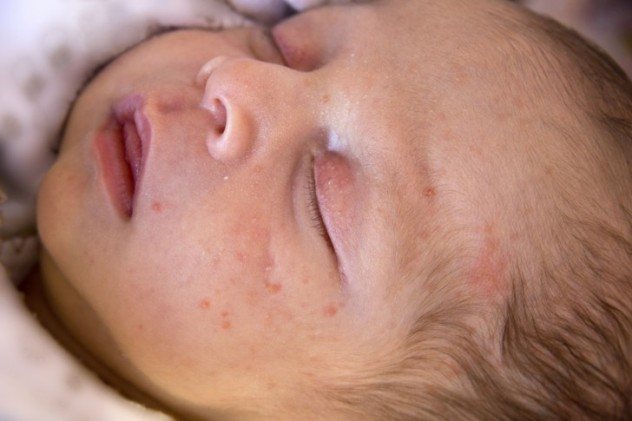
At the time of the baby’s adaptation to a new life, these rashes are considered a normal reaction of the body. In addition, they do not cause physical discomfort to the child. Pimples don't hurt, don't itch, don't sting. Therefore, there is no reason to worry about acne in newborns.
If a rash appears on the body and face of newborns, then to get rid of it as quickly as possible, pediatricians recommend providing proper skin care:
- Products for hygiene procedures must be appropriate for the age of the baby.
- Cleansing of the skin (bathing and washing) is carried out regularly.
- After water procedures, there is no need to quickly dress the child. Air baths are very useful for normalizing skin condition.
- In sunny weather, you can sunbathe a little (just not in direct sunlight).
Following these simple rules is considered to be a treatment for acne in newborns. Pimples will dry out much faster, and new papules will stop appearing.
At the same time, illiterate actions, on the contrary, can aggravate the situation:
- Do not lubricate areas with rashes with oil, lotion, creams (even for children). The application of these products will contribute to blockage of the ducts.
- The use of powders or ointments with antibiotics is contraindicated. Clean and dry skin will return to normal much faster.
- It is strictly forbidden to try to squeeze out blackheads. This leads to infection of the wounds. In addition, after such actions, scars remain on the skin.
- Do not use antiseptics (iodine, chlorophyllipt, brilliant green).
Before treating acne in newborns, you should definitely consult a doctor. After examination, he will determine which remedy is suitable in each specific case. This could be Sudocrem, Eplan, Bepanten, zinc ointment. Apply the drug only pointwise, several times a day. By following all the recommendations, you will be able to quickly resolve the problem.
A breastfeeding mother needs to avoid stress and anxiety. With negative emotions in a woman’s body, the production of the hormone cortisol increases, which worsens problems with rashes on the baby’s skin.
Acne or rashes can appear in an infant in the form of closed comedones. A comedon is an inflammatory rash that appears as black dots or white nodules. The size of a comedone in a child reaches 1-2 mm. It is possible that the spots will merge into one.
- swelling of the genital organs in male children
- In female children, the mammary glands become coarser
- boys have hydrocele of the testicular membrane
If you have any doubts about whether the rash is due to acne or an allergy, you should consult a doctor. There you will receive an accurate diagnosis and, if necessary, undergo several tests, for example: dermatoscopy and others. Most often, treatment is carried out at home and independently, without requiring the intervention of doctors.
- Ventilation of the room, frequent walks with the child in the fresh air.
- Keeping the child's skin clean, contacting safe detergents.
- Do not use brilliant green, potassium permanganate, creams or lotions when treating.
- You should not squeeze acne on a child. This will contribute to the penetration of infection to the sebaceous glands and aggravate inflammation.
- Several times a day, in order for pimples to go away, you should treat them with Bepanthen or zinc ointment. The drugs dry out acne and remove them.
- Sunbathing for a child has a great effect on the immune system and prevents the onset of illness.
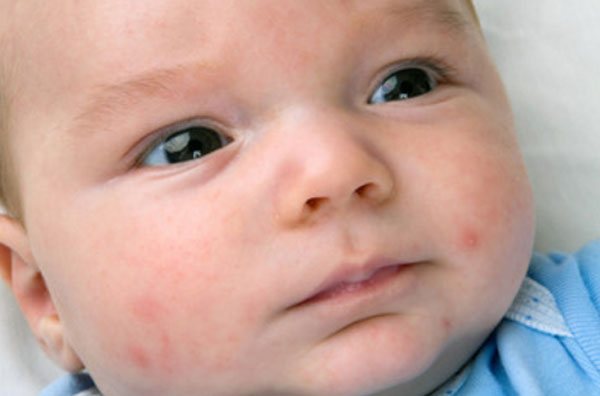
In cases where acne is very severe, doctors recommend the use of antibiotics, antiseptics, and vitamins. You can lubricate pimples with Panthenol. But you should not use strongly drying products, since the baby’s skin is too delicate, soft and sensitive.
Topical retinoids are used to treat acne. It is possible to combine the drug with local antibiotics, for example, clindamycin, erythromycin. It is not recommended to use tetracycline in the treatment of acne in children; tetracycline interferes with the full development of the child’s teeth and bones. Doctors recommend isotretinoin in some severe cases. The drug is not suitable for use at older ages.
Newborn acne is not an infectious or allergic disease (it is a hormonal rash); it does not need to be treated with anything.
Acne is not contagious.
There is no need to smear the rashes that appear with brilliant green, fucorcin, chlorophyllipt, potassium permanganate and any other antiseptics. It is better to carefully wipe the affected areas with a decoction of string or chamomile. Make sure your baby's skin is clean and dry. You can lightly lubricate the pimples with Bepanten ointment every 3-4 days (the ointment will dry out the rashes).
Please note: do not squeeze out purulent pimples. Recovery from this will not go faster, but the inflammation will intensify, and an infection may get into the wound. After healing, unsightly scars may remain in place of squeezed pimples.
Note to moms!
Hello girls) I didn’t think that the problem of stretch marks would affect me too, and I’ll also write about it))) But there’s nowhere to go, so I’m writing here: How did I get rid of stretch marks after childbirth? I will be very glad if my method helps you too...
Acne goes away on its own after maternal hormones are completely eliminated from the baby’s body and the functioning of its hormonal system returns to normal. The recovery process can take from two weeks to one and a half months. There will be no traces left after pimples (of course, if you didn’t try to squeeze them out).
Consultation with a pediatrician is necessary in any case. He will make the correct diagnosis and give recommendations for care and treatment. It is very easy to confuse acne with manifestations of food allergies or urticaria. But allergies and hives need to be treated!
Newborn acne: main causes
Some parents are simply sure that the disease occurs due to improper care of the child. We can reassure you a little, newborn acne occurs for completely different reasons.
The main cause of dermatological problems is the restructuring of the hormonal system. At this age, the child begins to intensively produce sebum. This is why acne occurs on the skin.
The second reason for its occurrence is the effect of maternal hormones. At an early age, maternal hormones are still in the blood of the newborn baby.
It is necessary to clearly understand that such a disease is not infectious in nature, and certainly not considered a contagious infection. Therefore, this problem refers to disorders of the functional state of the body.
Infant acne begins to develop between the ages of 3 months and 6 months. The cause of the development of a functional disorder can be hormonal imbalances. At the same time, increased production of androgen occurs in the body, directly from the child’s adrenal glands. Neonatal acne, namely infant acne, most often occurs in boys.
There are several stages of development. Mild functional disorders are treated with simple therapy. In severe cases, dehydroepiandrosterone sulfate begins to increase in the child’s body, namely in the blood. Therefore, treatment must be comprehensive and take place under the strict supervision of the attending physician.
Recommendations
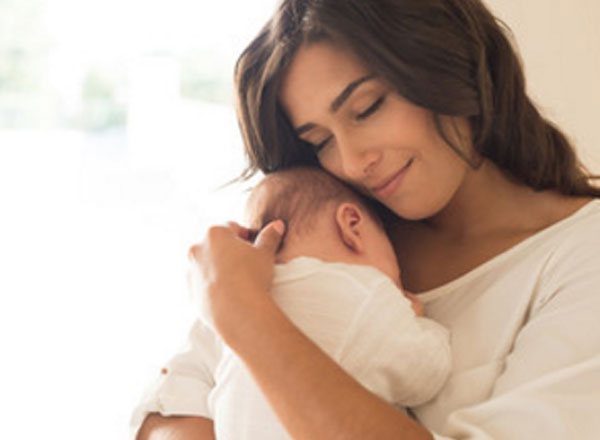
A mother's peace of mind plays a big role in her baby's health.
Although in most cases the disease passes without a trace, it is still necessary to adhere to certain rules.
- Do not squeeze out pustules. This way you only risk getting an infection through an open wound. In addition, there is a risk of scarring.
- Do not burn the rash with antiseptics or alcohol-containing medications.
- It is necessary to use cosmetics for child skin care only with special o.
- If acne spreads at an accelerated pace and increases in size, then you should definitely consult a doctor. Most likely, acne is of bacterial origin.
- If your baby is breastfed, try to avoid stressful situations. After all, the hormone cortisol, which is produced at the same time, has a bad effect on the condition of the toddler’s skin.
- Taking a bath with a decoction of string and chamomile has a positive effect.
- Also pay special attention to your diet.
- Hardening procedures, sunbathing, and walks in the fresh air have a beneficial effect.
How to get rid of comedones?
If parents discover acne in an infant, the first thing they will need to do is treat it with an antiseptic solution. At the same time, doctors draw attention to the fact that squeezing such pimples is strictly prohibited. These manipulations can only worsen the situation. To get rid of comedones, you will need to visit a medical facility, where diagnostic measures will be carried out and the correct treatment will be prescribed.
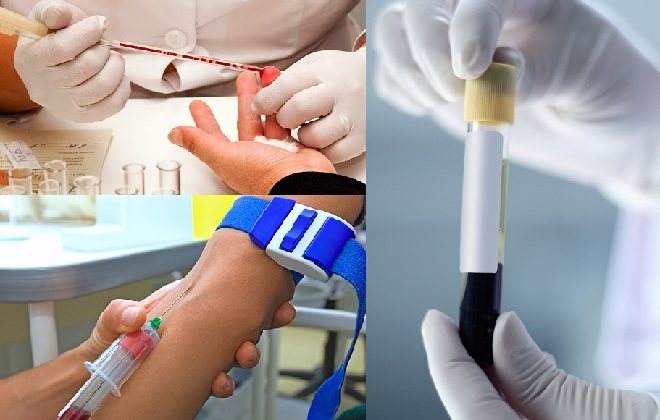
To prevent negative consequences, it is recommended to undergo a full examination.
At the appointment, the doctor first conducts a survey of parents, during which he finds out how long ago the skin problems appeared. Then the doctor begins to examine the skin and sends the little patient for examination. Sometimes it is necessary to take a scraping of the skin. For these purposes, the comedone is opened and its contents are examined. If there is a suspicion of disruption of the endocrine system or a hormonal imbalance, the child is sent for a general blood test.
When problems with hormones are confirmed, they resort to medications that help normalize the hormonal system. In addition, antibacterial medications, hepatoprotectors, sorbents and vitamin-mineral complexes may be prescribed. The correct medicine and the duration of its use are determined by the doctor, taking into account the severity of the diagnosed pathology and the characteristics of the child’s body.
Precautionary measures
Acne is a disease that appears due to hormonal imbalance, so protecting your baby from the appearance of a rash is quite problematic. To reduce the risk of flowering, you must adhere to the following preventive measures:
- monitor the child’s hygiene;
- strengthen the immune system (daily walks, air baths, reducing the temperature of the water when swimming);
- maintain optimal temperature and humidity in the child’s room (the room should not be hot and dry).
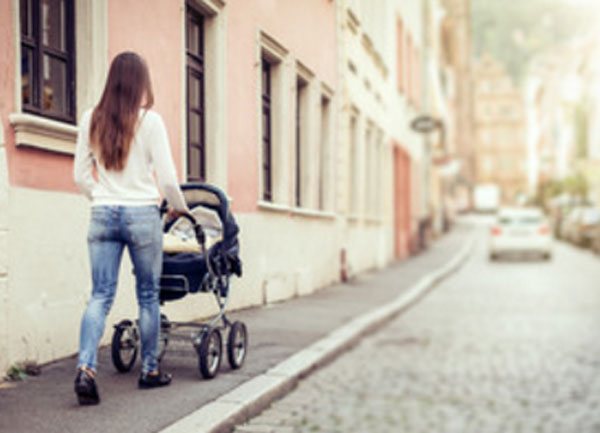
Take regular walks in the fresh air
Parents can do everything to reduce the intensity of rashes and speed up recovery.
- Get outside regularly.
- Pay attention to sunbathing.
- Don't forget about daily hygiene procedures.
- Strengthen your immune system through hardening and vitamin therapy.
- Use children's skin care products.
- Watch your diet.
- Avoid stressful situations and do not expose your child.
Now you know what acne on the face of newborns is. Your task is to pay attention in time to the appearance of a rash on the child’s head and consult a doctor. You shouldn’t put it off and hope that everything will go away on its own. Although there is no need to exclude this option. Remember that it is strictly forbidden to squeeze out pustules on the delicate skin of toddlers.

